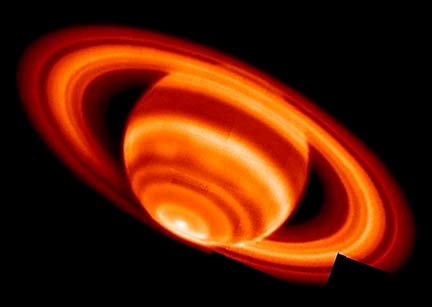
|
Mauna Kea yields
Saturn insight
WAIMEA, Hawaii » The south pole might not seem like a sensible place to warm up, but astronomers on Mauna Kea have discovered that's where to find the warmest weather on the planet Saturn.
"Warm" in this case means 188 degrees below zero Fahrenheit. That beats the temperature elsewhere on Saturn, 208 degrees below zero.
The odd thing about this polar "hot spot" is that it has a distinct boundary with the temperature dropping off rapidly at the border of the warm zone.
These are the findings Glenn Orton, who researches weather on other planets, made last year using the Keck Observatory on Mauna Kea.
Orton's discoveries were released yesterday in a new issue of Science magazine.
Finding warmth at one of Saturn's poles is not entirely surprising, a Keck statement said. Like Earth, Saturn is tilted on its axis, so one pole and then the other gets continuous sunlight for part of the year.
On Saturn, which takes 29.5 Earth years to go around the sun, the south pole has been pointed at the sun for the last 15 years. That should mean fairly uniform warming in Saturn's southern hemisphere.
Instead, when Orton made an infrared image of Saturn's low-level atmosphere, he found a bright dot of heat right at the pole.
When he looked at the upper atmosphere in a different shade of infrared, he found a disk of heat with a distinct boundary stretching out some distance, then a cooler ring, also with a distinct boundary, reaching farther.
The kind of wind pattern that might create this effect is also seen on Earth. It creates the ozone hole around the Earth's south pole.
But on Earth and on Jupiter, Mars and Venus, these "polar vortexes" are colder than surrounding air. Saturn is the first planet where a hot one has been found.
The Saturn "hot spot" might be caused by particles in the vortex trapping heat. Similar polar heating has been seen on Earth, but it is "very short-term," Orton said.
For Saturn, astronomers have seen hints that this hot spot has lasted at least two years, he said.
Scientists hope for more information from the European-American space probe orbiting Saturn when it can see the south pole in March through May.
www2.keck.hawaii.edu
UH Institute for Astronomy
www.ifa.hawaii.edu
Mauna Kea webcams
mkwc.ifa.hawaii.edu/current/cams/
[News] [Business] [Features] [Sports] [Editorial] [Do It Electric!]
[Classified Ads] [Search] [Subscribe] [Info] [Letter to Editor]
[Feedback]
